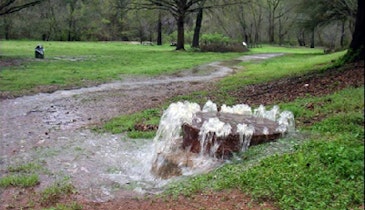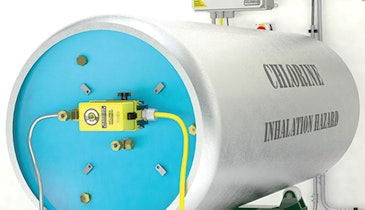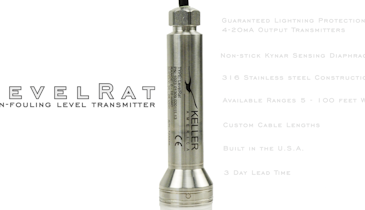Interested in Recovery/Reuse?
Get Recovery/Reuse articles, news and videos right in your inbox! Sign up now.
Recovery/Reuse + Get AlertsLast August, national news reported a historic low water level in Lake Mead, the source of water for much of the Southwest.
As a result, the U.S. Bureau of Reclamation announced the first-ever water shortage for the lower Colorado River; water release reductions to Arizona, Nevada and northern Mexico were announced for 2022 to make sure the lake contains enough water to continue electric power generation and supply water for essential uses.
Along with extreme drought in the West, it’s another symptom of change in water supplies. Meanwhile, on the other side of the nation, Florida has taken aggressive measures to help ensure reliable water supplies by passing a law that would all but eliminate discharges of wastewater effluent to surface waters.
Under the law, wastewater utilities had until Nov. 1 to submit plans to eliminate “nonbeneficial surface water discharge” by 2032. There are limited exceptions, such as for discharges related to indirect potable reuse projects, wet-weather discharges and reuse systems that recycle at least 90% of annual average wastewater flow.
The WateReuse Association is dedicated to advancing laws, policy, funding and public acceptance of recycled water. Patricia Sinicropi, executive director, and Robert Beltran, president of WateReuse Florida, talked about the state’s law and larger trends toward water recycling in an interview with Treatment Plant Operator.
Given that most people don’t look at Florida as a water-scarce state, what drove the adoption of this law?
Sinicropi: Florida has been discussing this approach for several years. The state has several challenges related to water and water supply. Of course they have a coastline that they are interested in protecting. They have very shallow groundwater, and they are draining their aquifers at a rapid rate.
Sea level rise is putting pressure on the coastal aquifers, and they’re experiencing saltwater intrusion in several areas due to over-pumping of groundwater resources. With population growth, the state expects to need an additional one billion gallons of water per day by 2040. Florida has also struggled mightily with nutrient issues, not only in the ocean waters but on inland lakes. All of those factors combined to lead the state aggressively down the path of expanding an already robust water reuse program.
Beltran: In 2010, reuse was not included by water management districts as a source of drinking water. Through the effort of utilities, we were able to educate regulators and legislators about the importance of reuse as an option for drinking water. Since that time the districts and Department of Environmental Protection have assisted with funding and time to support reuse.
Why was this an opportune time for the state to take this action?
Sinicropi: Water recycling technology has improved to the point where we now have the ability to treat virtually any source of water to a quality appropriate for any purpose. In fact, the Florida Department of Environmental Protection is developing rules for potable reuse, thanks to the advocacy work of the Florida Potable Reuse Commission, chaired by WateReuse Florida.
Some communities will decide that the most efficient way to reduce surface water discharges of effluent is to treat the water to meet drinking water standards. In Florida and elsewhere, we’ve had more than three decades of experience with safe and beneficial water reuse. Given that the technology works, is affordable, and can help the state meet its water supply needs, Florida was able to consider what it means to eliminate discharges to surface waters and to ocean outfalls.
What were some of the challenges to adoption of this law?
Beltran: The science has been there to treat reuse to drinking water requirements. The “yuck factor” has been a hurdle, but studies have found that this can be overcome through education. The One Water Florida initiative, supported by WateReuse Florida, is an example of efforts to highlight the benefits of recycled water and how it will safely supply Florida’s future.
What will be involved for communities and clean-water utilities to make the transition to beneficial reuse?
Sinicropi: Florida has a lot of purple pipe already, but for many communities it’s going to require significant planning. Many are already preparing for the transition. For example, Jacksonville, Hillsborough County, Altamonte Springs and Tampa are already moving pretty aggressively toward potable reuse programs. For the most part it is indirect potable reuse by way of aquifer recharge. A lot of investment will be needed to realize those plans.
Looking at the bigger picture, do you see other states moving in this direction?
Sinicropi: We’re seeing a similar push in California, where they now have a study bill to examine whether they could adopt a similar policy in the future, I don’t think we’ll see this approach in many other states, but in Florida, which has a long history of water reuse, it is a viable strategy.
How do you see western and southwestern states dealing with drought conditions taking action on water recycling?
Sinicropi: I think we’ll see more and more water reuse; whether the legislatures in those states will implement mandatory recycling, I don’t know. It involves a great deal of policy and political discussion. I do know that water managers in those states are developing plans that call for significant recycling in the future. There are over 300 new water recycling projects in various stages of planning in that region.
Can you cite any specific examples?
Sinicropi: Los Angeles has declared that it will move to 100% water recycling by 2035. The Metropolitan Water District, a wholesale supplier of water to 26 water agencies in southern California, is going all in for water recycling in the future. States like Arizona and New Mexico are very strongly moving in the direction of full water reuse. Utah, Nevada and other states are already undertaking significant recycled water programs.
How do you see wastewater utilities in Florida responding to and ramping up to comply with the new law?
Beltran: First, they will pilot test different treatment options and start public education. The treatment scheme must include safeguards to ensure that quality is not compromised at any time. One model to follow is San Diego, which did a great job of turning public opinion with its education program. Other utilities are following that lead to increase public awareness of the benefits to the environment and build support for a sustainable water supply.
What is the role of the WateReuse association in helping these plans move forward?
Sinicropi: One of our primary roles is making sure there is sufficient federal and state investment in reuse. In fact, the bipartisan infrastructure package before the U.S. Congress includes $1 billion for such investments through the Bureau of Reclamation. We’re working very hard to secure funding for a nationwide water recycling program because we believe many communities east of the Mississippi will eventually face questions similar to those Florida is addressing. We’re working to get a nationwide grant program set up and funded.
How does that advocacy play out at the state level?
Sinicropi: Our state sections are working with their legislatures to make sure money is set aside in state budgets to help communities move toward recycling.
How does your association support recycling at the level of policy?
Sinicropi: Our role includes making sure the rules in place at the federal and state levels facilitate the adoption of reuse programs, or at least don’t present barriers to communities that want to move in that direction. We also provide informational tools and resources. Our website offers a number of communication tools to help the public, educators and policymakers learn about the safety and benefits of recycled water. We play a number of roles in supporting the policies and providing the public education tools needed to make reuse programs succeed.
How is the association active in the technology sector?
Sinicropi: We’re not a research association in terms of investing in technologies, but we do have several technology providers at the table discussing best management practices and sharing information on innovative technologies coming onto the market that can improve efficiency and treatment quality in recycled water programs. We provide a forum for technology providers and people interested in innovation to share their experiences with our membership.
Will we see a time when water recycling, rather than effluent discharge, is the default position for clean-water utilities?
Sinicropi: The water world is going to look very different in 50 years. We’re seeing the evolution take place. The more people grow comfortable with water reuse, and the more they understand how technology can produce recycled water that is safe for both potable and nonpotable uses, the more communities everywhere will think differently about discharging effluent into water bodies that may not be the best receptacles for it. What we call “wastewater” is not waste at all; it’s a resource that can be treated and used over and over again for a variety of beneficial purposes.





